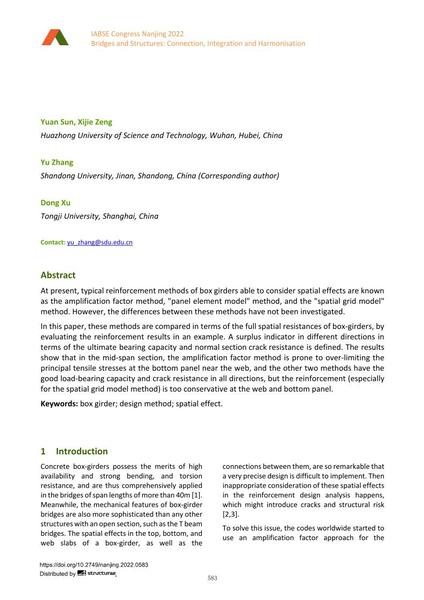A Comparison Study of Reinforcement Design Methods of Concrete Box Girder Bridges Considering Spatial Effects

|
|
|||||||||||
Détails bibliographiques
| Auteur(s): |
Yuan Sun
(Huazhong University of Science and Technology, Wuhan, Hubei, China)
Xijie Zeng (Huazhong University of Science and Technology, Wuhan, Hubei, China) Yu Zhang (Shandong University, Jinan, Shandong, China (Corresponding author)) Dong Xu (Tongji University, Shanghai, China) |
||||
|---|---|---|---|---|---|
| Médium: | papier de conférence | ||||
| Langue(s): | anglais | ||||
| Conférence: | IABSE Congress: Bridges and Structures: Connection, Integration and Harmonisation, Nanjing, People's Republic of China, 21-23 September 2022 | ||||
| Publié dans: | IABSE Congress Nanjing 2022 | ||||
|
|||||
| Page(s): | 583-591 | ||||
| Nombre total de pages (du PDF): | 9 | ||||
| DOI: | 10.2749/nanjing.2022.0583 | ||||
| Abstrait: |
At present, typical reinforcement methods of box girders able to consider spatial effects are known as the amplification factor method, "panel element model" method, and the "spatial grid model" method. However, the differences between these methods have not been investigated. In this paper, these methods are compared in terms of the full spatial resistances of box-girders, by evaluating the reinforcement results in an example. A surplus indicator in different directions in terms of the ultimate bearing capacity and normal section crack resistance is defined. The results show that in the mid-span section, the amplification factor method is prone to over-limiting the principal tensile stresses at the bottom panel near the web, and the other two methods have the good load-bearing capacity and crack resistance in all directions, but the reinforcement (especially for the spatial grid model method) is too conservative at the web and bottom panel. |
||||
| Mots-clé: |
caisson
|
||||
| Copyright: | © 2022 International Association for Bridge and Structural Engineering (IABSE) | ||||
| License: | Cette oeuvre ne peut être utilisée sans la permission de l'auteur ou détenteur des droits. |
||||
